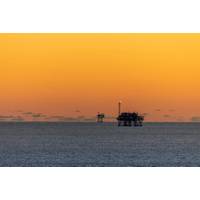Exxon Mobil Corp on Wednesday outlined an ambitious capital spending plan it said would more than double annual earnings by 2025, hoping to allay investor fears that the world's largest publicly traded oil producer has seen its best days.
Despite the ambitious plan to woo Wall Street, Exxon shares slid 3.1 percent to their lowest level in more than two years.
Once the industry's profit and cash-flow leader, Exxon now lags rivals. Sagging profits and a declining share price have pushed total return, share appreciation plus dividends, into negative territory over the last five years, according to Thomson Reuters data.
By comparison, total returns are up 16 percent for Chevron Corp and 40 percent for Royal Dutch Shell Plc.
Exxon's growth plan will require billions of dollars in spending spread across low-cost shale fields, refinery expansions and deepwater megaprojects. The company said investments should drive profit to $31 billion in 2025 with crude prices at or above current levels.
It was the first time Irving, Texas-based Exxon has given an earnings forecast so far in advance. Exxon did not announce a stock buyback program, something analysts had been seeking. Shares fell 3.1 percent to $73.80, in midday trading.
Darren Woods, who became chief executive in January 2017 after predecessor Rex Tillerson retired and became the U.S. secretary of state, also said he was committed to being more transparent with investors.
"There's a lot different today, not just style," Woods said at the company's annual analyst day in New York. "My objective is to get this organization focused on driving value and turning that value into results that you all will see."
In response to an analyst's question if he would resign if the targets were not met, Woods did not directly reply, but said he intended to meet the long-range goals.
Exxon said exploration projects in Guyana and the Permian Basin, as well as refining and chemical plant expansions, should drive earnings gains. Exxon reported an adjusted profit of $15 billion in 2017.
Exxon is increasing its budget to achieve its goals, spending $24 billion on capital projects this year, $28 billion next year and an average of $30 billion from 2023 to 2025. Meanwhile, peers including Chevron are cutting spending or promising to hold budgets flat.
"Capex is the price you pay for cash flow," said Woods, who added that every dollar in capital spending by Exxon in the past decade has generated $1.20 in operating cash flow.
Woods said he expected production to grow about 1 million barrels of oil equivalent per day (boe/d), to about 5 million boe/d in 2025 as 25 projects come online.
In the Permian Basin of Texas and New Mexico, the largest U.S. oilfield, Exxon plans to triple production by 2025 by recently purchased low-cost acreage. The expansion highlights the increasing importance of U.S. shale alongside its global megaprojects.
NO EASY FIXES
Several analysts viewed the higher spending as problematic, even as they said welcomed the pledge of greater transparency by a company criticized for giving few operations details in recent years.
"To us this highlights that there are no easy fixes to rejuvenate Exxon's portfolio, and it is likely to take time for this investment to flow through into higher earnings, cash flow and returns," said RBC Capital Markets analyst Biraj Borkhataria.
Exxon's operating margin, which measures profit after expenses, dipped to 5.1 percent last year, far below the industry median of 13.5 percent, according to Thomson Reuters data.
Several analysts pushed Woods for still more transparency, asking him directly to participate in quarterly earnings conference calls. Unlike CEOs of most public companies including oil majors, Exxon CEOs historically have not joined the calls, where analysts can ask for operations details and outlooks.
"Please disclose more and meet us more. We would be greatly appreciative," Wolfe Research analyst Paul Sankey said to Woods at the meeting. Woods did not commit to being on the calls, but said he has been meeting more with investors in the past year.
Chevron on Tuesday said it should be able to raise production 4 percent to 7 percent this year and buy back shares for the first time in at least three years even without a substantial rise in oil prices.
Reporting by Ernest Scheyder


